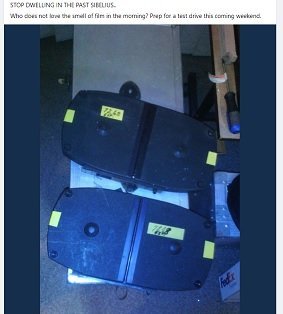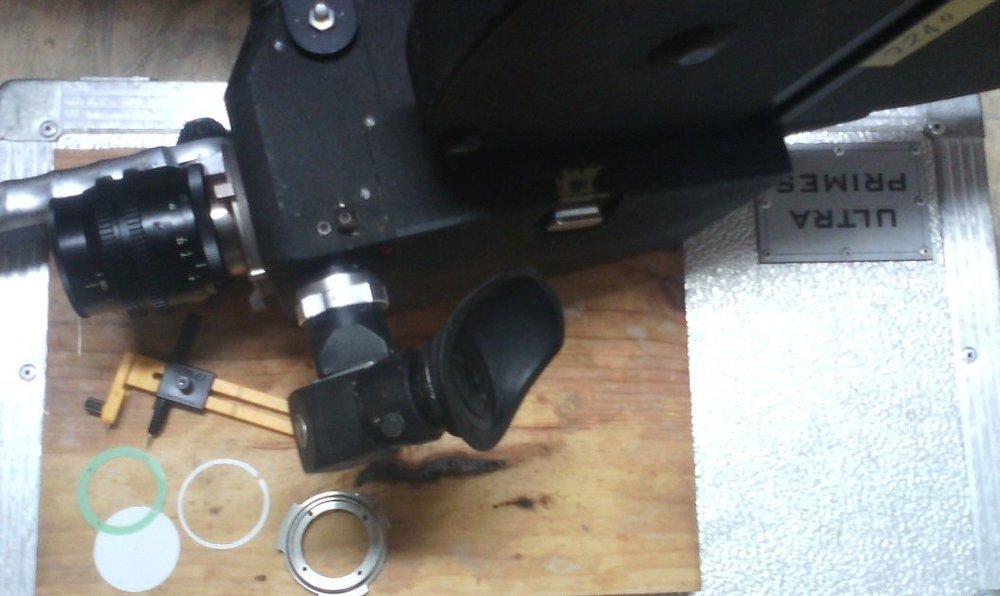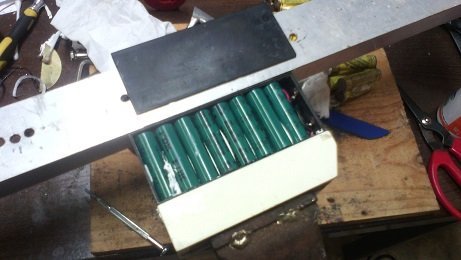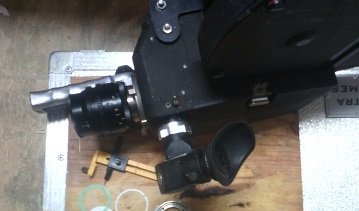
Robert Hart
Basic Member-
Posts
378 -
Joined
-
Last visited
Everything posted by Robert Hart
-
Arri Standard to PL mount recommendation
Robert Hart replied to Raymond Zananiri's topic in General Discussion
Be careful with some of the cheaper adaptors. They do not have a clearance chamfer machined in the front of the inner diameter of the flange face of the adaptor. The sharp edge bears against a fillet radius on the lens tail. This prevents the adaptor from engaging face-to-face contract and causes inability to focus the lens to infinity. -
YOUNGER FOLK STILL WANT TO EMBRACE FILM
Robert Hart replied to Robert Hart's topic in Cinema Products
The essence of course is that the successful practitioners are adaptable, can shoot with film or digital and have built the knowledge to choose the right tool for a particular purpose or aesthetic. They may not even own an industry level camera. They may well have the best common sense of the lot of us. When the scientists have perfected the headset which taps into people's brains and the democracisation of filmdom is complete, there will still be masters of the realm. If we think we are overwhelmed with choice now, just imagine the amount of sheer dross which will be propagated in the future that we will have to filter through to find the rare gems after donning our AR headsets. Then again, if Einstein's prediction is correct and we bomb ourselves back into the stone age, our motion picture experience could become walking with a handheld burning stick, head turned, blinking our eyes to animate a sequence of drawings along the cave wall. -
YOUNGER FOLK STILL WANT TO EMBRACE FILM
Robert Hart replied to Robert Hart's topic in Cinema Products
A 4K scan of 16mm certainly looks fine as there are subtle elements of sharper image resolved across several frames that a 2K scan does not see. By "clarity audiences are becoming accustomed to", my opinion is that 4K display in cinemas is now the benchmark they are enjoying. The not so recent film exhibition experience took a dip when cinemas kept their film projection lamps operating up until their olive-green coloured death. They did not bother with trimming focus through the initial heating cycle of the optical path or checking the horizon of the anamorphic display lens. Now cinema audiences have had something given back. I was a bit of a pest during a Sony product evening way back when HDCAM was being promoted. A statement was made about digital video having better resolution than film and I contradicted this in the Q and A session, suggesting that originators using film might think something different. The compromises of a 2K post-production pipeline hobbling 35mm film resolution were conceded. In the next few weeks I will be alone, shooting some interviews with an aviator in situations that a sync film camera and recorder simply would not be friendly for. I have shot one-man-band with a film camera and an analogue sound recorder. It can be done but with inevitable compromises. With digital, the value-adding is in the flexibility and immediacy that film would require a crew and its impact to achieve. As for technical complexity, I prefer the film camera which except for the electronics I can keep serviceable myself. I can take a clockwork Bolex wrapped up in a sleeping bag into a remote area and forget about batteries. With the digital cinema camera, I always fret whether something is going to open up inside the electronic complexity somewhere and the camera may not wake up. Ultimately what happens to the end-product shakes down to what the marketplace will bear. For now at least, it is a horses for courses thing. Deep austerity measures we will experience over the coming 25 years while governments redeem their war and pandemic debts. All entertainment will fall victim to the decline in the "discretionary spend". Finally my comments are an expression of personal opinion as were those of another respondent to my comments. I thank my fortune in living in a country where people can still express an opinion. -
YOUNGER FOLK STILL WANT TO EMBRACE FILM
Robert Hart replied to Robert Hart's topic in Cinema Products
"But it is bad to shoot projects with film wondering if it will 'turn out' as we used to say." Perhaps I should clarify. Two retired cameras were serviced and some old expired stock was brought out as an experiential for younger folk and the actual doing of it, rather than a production as such. The purpose was to compare the two regimes, digital and film in a lighting exercise among a group of friends. The scene was lit to suit the sweet spots of the lenses of the film camera and the estimated ISO of the film stock which was between ten and twenty years old. The digital cinema camera was a Sony FS6. With competent practitioners working with film along its entire progression from aquisition through processing to viewing, there should be no doubt about the image "turning out". I concede that the risk chain of filmed image aquisition was greater. However when it was mainstream, if everyone along the chain was doing their job, here was little more risk than a digital image file becoming corrupted or a drive laying down before the mandatory safety copies are made. "Have a little pride in your still work even if it is not your main area." The late Aussie PM, Sir Robert Menzies once said, "Self-sufficiency is the first instinct of a proud man". As for still photography, those images were casual pickoffs with a phone camera whilst staying out of everyone's way. At age 74 and counting the mile-markers along the downslope, caring about future career progress is no longer a consideration. Yes. Digital is the way forward and certainly a lot of material wastage is eliminated. I possess, operate and enjoy a damaged Blackmagic Ursa 4.6K-EF, which I patched up from wrecks, so I am no stranger to digital imaging and embrace it. Modern digital post beats the hell out of sitting at a Steenbeck syncing film takes before one can even dream about cutting. Film which was once a familiar tool is no longer affordable for me. 16mm in its Super16mm form as a workaday tool falls short of the image clarity digital audiences are becoming accustomed to. The former cost-barrier of film which tended to filter out some of the dross from commercial product is now missing. So we will see more sub-par digital audiovisual fillbelly for streaming. Those who can easily afford the indulgence of film at a hobby level will throw together some inferior work. The need to eat and pay the rent tends to sharpen one's competences in any field of endeavour. However there is no harm in dwelling on the past whilst the tech is still available for folk to touch and feel. After all, people are still doing plate photography not because they should but because they want to and can. I was being a little self-deprecatory in a social media post about this before the event. -
There was a little lighting session today, mixing it up with digital cinema and 16mm film. In a few weeks the truth will be telling on whether the old film stock worked.
-
Converted Arriflex ST Super 16mm by ARRI - they exist!
Robert Hart replied to Uli Meyer's topic in 16mm
That is a photogenic neighbourhood and family subjects and interactions are sweet. Digital sometimes has a problem with a hard sky ( light even overcast ). The ground and subject look fine but the sky, not so much. -
A few years back I tried a cut piece of Formatt Hitech 1/8 contrast filter behind the OPLF in a SI2K camera. There was a subtle "apparent" slight extension of the histogram but as for the look, not much seemed to change. I also tried IRND to place the lens iris in the sweet spot and an Ultracon 3. Whatever the ARRI secret sauce is, the optical filter panel in the camera throat is probably not it.
-
Converted Arriflex ST Super 16mm by ARRI - they exist!
Robert Hart replied to Uli Meyer's topic in 16mm
Real film. - There is nothing quite like it is there. Your posted vision looks excellent. It is good that vintage cameras live on instead of going rusty in an attic somewhere. That butcher work on the filed out gate a few pages back is really quite brutally distressing. The artisans who did the original good work deserved better than to have their pieces munted irrepairably like that. I have modded a CP16R and a Bolex H16RX5 for Super16mm and live with the offset centre in the viewfinder. For the Bolex, I had an old Fujinon TV-Z zoom which had excellent contrast and covered the wider gate. Some sod stole it. The CP16R mount could not be easily re-centred so instead I made offset tails for the lenses I was using. I imagine that ARRI would have moved the mount centres in the lens turret outwards to re-centre the lenses. A downside of reducing the width of the rail is more unsupported area of film. The old golden rule of "cleanliness is next to godliness" applies. So long as the surfaces are highly polished and kept clean, scratches should not be a problem with rails bearing on the image area. -
I think it is called living within your means. To be truthful, modern drones are creating wonderful vision that mortal like me could never have dreamed about in younger years. A guy with one of those little hand-held DJI doovers on a stick actually got better follows of an aircraft lifting off than I did with an URSA Mini 4.6K camera on a tripod. Will you be taking a chance and doing a low-level slow approach to an oncoming locomotive then lofting over with a tiltdown onto the loco and wagons passing below? All the best in your endeavours.
-
Film still rules it seems and it is good to see. Would there be any utility in considering the cost of a digital - film - digital route for the drone footage versus hiring something a human cammo can fly in, using a wide lens on your Bolex and a faster frame rate if it is available on the EDM? Some pilots may be too anxious to please and paint themselves into a corner. You also need to be mindful of a pilot's high workload during a flight. Task saturation is a real thing and does not take much to extra tasking or distraction to clutter the mind. The aerials on this 1990s documentary were shot handheld with an old spring H16RX5 Bolex at a faster frame rate to deal with the involuntary athletics of a Robinson R22 mustering helicopter's vibrating rotor system. The cameraman was unimpressed with the fan belts which are the primary drive system in the R22. The reality is that they are reliable. The filmies also used a little Subaru AWD wagon for the first cross-country part of their shoot. They later bought a Toyota 4WD wagon for the remainder of the shoot and sold it off afterwards. https://ictv.com.au/video/item/1063
-
Shooting in photo dark room
Robert Hart replied to Alberto Res's topic in Visual Effects Cinematography
Maybe go the infrared route with infrared lighting and no visible light. Mixing infrared and visible light may soften the image. You will have to do some post work with hues. It was customary for vision of print work being done in a B&W photo lab to be red hued in depiction of the safelight. I understand that it was also possible for the developing print to be photographed under light although it could become ruined. -
For sake of experiment, I fitted a 1:33 anamorphic adaptor on front and a custom Laowa 1:33 rear anamorphic Nikon F-Mount to PL-Mount adaptor on the back of a Nikon stills lens to attempt a near-to 2X anamorphic effect. It appears to be doable ith lenses in the focal lengths 50mm and longer. With a 40mm there appears to be a corner vignette. The combination yields a crisper result than using a 2X anamorphic projection lens. With a PL-Mount to PL-Mount rear anamorphic adaptor and a decent PL-Mount anamorphic lens on the front more realistic results than my Nikon experiment might be achieved in lieu of going the high cost of rental route.
-
Making new Crystal Sync electronics for CP16R
Robert Hart replied to Aapo Lettinen's topic in Cinema Products
Aapo. Have you let Paul Hillman at Visual Products know about your latest intentions for the CP and Eclair controllers. You might also need to register your designs in the US to protect them from reverse-engineering by folk who might get them assembled on the cheap in China. -
They may be a bit out of your league pricewise but on a shoot with the SI2K some years back a set of Zeiss CP2 compact primes for 35mm cameras used on a second camera yielded a sharpness and contrast comparable with dedicated Super16mm lenses I had on the main camera. The Optika Elite Super16mm lens range also included an 85mm T1.4. Finding a used one for sale may be a challenge.
-
Making new Crystal Sync electronics for CP16R
Robert Hart replied to Aapo Lettinen's topic in Cinema Products
Thanks for that. Shutter parking whilst convenient for eliminating flash frames and enabling the reflex viewfinder could be eliminated if the added circuitry causes difficulties as I expect it will. A replacement opto-interrupter would be needed for the small shutter disk which is towards the front of the camera. There is a small LED and detector built onto the existing circuit boards which sandwiches the rotating small shutter much like the interrupter disk on the motor itself. Some video cameras with infrared detection or a night vision can see the LEDs glowing. For setups where focus positions and marks are critical prior to rolling, the mirror could be reset to the viewfinder finder's optical path by simply removing the lens and moving the shutter manually via the open mount. Otherwise buttoning on and focusing during the slate would be fine with little or no wastage of film. The older CP16A I have just starts and stops. There is no shutter parking feature. Slightly offtopic, in a recent message exchange with Ken Hale, he mentioned that he has wondered why no one has examined designing daughter circuit boards to patch in and replace the hybrid ICs. -
Owning a cine lens set with full-frame lens coverage
Robert Hart replied to Paul Joseph's topic in Lenses & Lens Accessories
Being of an improverished nature, I think I may hang onto my old Nikon f1.4 lenses and the third-party wide-angle lenses. Anything better can always be rented. -
Making new Crystal Sync electronics for CP16R
Robert Hart replied to Aapo Lettinen's topic in Cinema Products
Aapo. You can put me down for a single-speed. It will be for a camera which I have gifted to some younger filmies which is in otherwise good condition. It is the second camera with the dummy sound head in the CP16R "how-to" videos I made some years ago. I gather you may require a deposit. If you do and advice via this forum does not contravene the forum's guidelines, please mention it here. Otherwise send me a private mail on this forum. The end of film warning feature would not be needed. If shouldering, one can hear the film run off. If using on a tripod, one can train one'self to watch the outspooling pulley on the magazine, someting I have done for some years. -
Making new Crystal Sync electronics for CP16R
Robert Hart replied to Aapo Lettinen's topic in Cinema Products
Slightly off-topic, would there be difficulty in designing and building a controller for a single speed for 24/25FPS geared cameras as stable and accurate as the original system which could be user installable or handed off to a local camera tech? Having the faster and slower frame rates would be sweet. Many owner-operators are probably only interested in the sync frame rates of 24 and 25 and there are plenty of affordable Bolexes and other types which can do the novel frame rates. -
OLD 7217 (7277??), 7248 AND 7291 RECANNED 16mm FILM.
Robert Hart replied to Robert Hart's topic in Film Stocks & Processing
Robert Houllahan. Thank you for your response. The present scheme is to overexpose by one stop and request standard processing. -
My understanding is that the ASA of old film stock needs to be regarded as one stop slower after ageing and over-exposed by that one stop to be assured of a recoverable image. If anyone has prior experience of successfully using expired 7217 (7277), 7248 and 7291, any advice will be appreciated. some folk who would like to shoot some old film on my older CP16R will likely appreciate it.
-
Dom. I am totally with you on that one. The calibration of the frame rate selector may be slightly out with moly paste. Once my camera had settled down after I roamed around inside, I loaded some clear leader and studied the shutter in the flicker of a PAL CRT TV screen. Without the pressure plate also dragging on the film it was pretty hit and miss as a test. I adjusted the speed until the flicker froze and the camera was synced up to 25FPS or 50Hz interlaced. My fixit was due to the camera having been heavikly dewed though it having been shipped to me in a freezer truck, then held for several hours before I was notified to go collect it. After cleaning out the moisture and adding lube where I tought it would be needed, The number on the control knob was just a hair past 24FPS which is pretty close. Not bad for a clockwork camera decades old. It holds sync for about fifteen seconds before drifting which again is not bad for clockwork.
-
Strange results from Bolex H16 with Kodak 250 D 16mm film
Robert Hart replied to Francesco Mussida 's topic in 16mm
Simon. If a dumb Tarzan has damaged the inner panel of the door by pressing it shut hard against the guide and pressure-plate release buttons without putting them in their correct positions where there are clearances in the door panel, the automatic realease button may not always work. I always make sure it has been pressed and the guides spring open before closing it. The door on my old camera bought secondhand was rather munted. -
For sake of some locals who would like to shoot with some long-expired film stock on a film camera, I have been checking over the CP16R I still have, servicing it and remounting a CP prime lens set to CP-Mount. I found that the batteries are not exactly in the best state as in mostly dead. However in a surprise, a battery which I re-celled in 2007 still seems to be good. How it will stand up under load is anyone's guess so I have re-celled a dead one. The two I did in 1988 are goneski. That's when I discovered that the original Nicad cells are no longer available. I was able to find a near-substitute in the form of Nimh cells which are very slightly longer and are extremely difficult to fit within the existing NC4 battery cases. To be sure the pack will fit again within the dock in the camera body I had to test-fit the battery before I sealed everything up, then to be sure, placed the battery in a lightly secured vise whilst the silicone sealer I use to bind the cells hardened. After bonding the cover on with the same material, I have inserted the battery in the dock whilst the material sets. The battery cells were only available untagged so resorted to cutting tags out of shim brass and soldering them on. This added length. The thickness of the battery case walls had to be dressed down on the inside faces before the outer faces were restored correct for width. The CP batteries always were a tight fit and the ubiquitous BIC biro pen blue cap with its tail was the most convenient means of getting a stuck battery to shift without injuring battery or camera by simply shoving it into the gap at the conductor pin end. I have discovered another problem. All the little plugpack chargers are dead. All initially powered up reluctantly, seemed to work but from go, the small red LED light would wax and wane until after about 30 minutes it went out. The common failure seems to be open-circuit in the transformers. One went "klikk" which sounds like a semiconductor dropping dead rather than a wire going open-circuit which is usually a "bvvvt-t" thing along with smell. The chargers are a fully sealed throwaway unit. The voltage selector switches were set correctly. One had been taken apart and put together again with Araldite so I was able to gouge out the Araldite, part the case and have a look. All the diodes seem to have become open circuit. There are some really spiderweb-thin secondary wires coming out of the transformer for the charger circuit. Getting the thing apart risks injuring those wires. I have rewound Dremel tool field coils but rewinding one of these is out of my league with that gossamer-thin enamel wire. The CP uses a strange choice of voltage, 20VDC. The charger's placarded output is 23VDC at 0.55mA. I have managed to find a small plugpack power supply which has taps for 20VDC and 24VDC at 1A, so for now will make do with those voltages and careful observation of the charging battery. If anyone knows of a suitable present-day alternative charger, I would appreciate advice.









